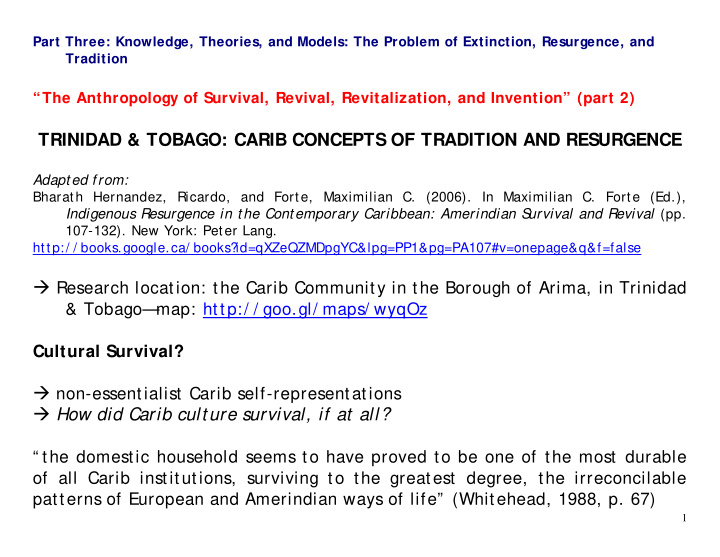



Part Three: Knowledge, Theories, and Models: The Problem of Extinction, Resurgence, and Tradition “The Anthropology of Survival, Revival, Revitalization, and Invention” (part 2) TRINIDAD & TOBAGO: CARIB CONCEPTS OF TRADITION AND RESURGENCE Adapt ed from: Bharath Hernandez, Ricardo, and Forte, Maximilian C. (2006). In Maximilian C. Forte (Ed.), Indigenous Resurgence in t he Cont emporary Caribbean: Amerindian S urvival and Revival (pp. 107-132). New York: Peter Lang. http:/ / books.google.ca/ books? id=qXZeQZMDpgYC&lpg=PP1&pg=PA107#v=onepage&q&f=false � Research location: the Carib Community in the Borough of Arima, in Trinidad & Tobago— map: http:/ / goo.gl/ maps/ wyqOz Cultural Survival? � non-essentialist Carib self-representations � How did Carib cult ure survival, if at all? “ the domestic household seems to have proved to be one of the most durable of all Carib institutions, surviving to the greatest degree, the irreconcilable patterns of European and Amerindian ways of life” (Whitehead, 1988, p. 67) 1
� proximity to eastern Venezuela and the Orinoco River Delta to the south � 1870s to the 1920s: the cocoa boom— results: displacement of the Arima Caribs, yet influx of culturally similar migrants from Venezuela (“ peons,” “ Cocoa Panyols” ) � Trinidad’ s Caribs and the “ Cocoa Panyols” : intermarriage, same language, same diet and agricultural practices, similar religious beliefs and practices � Other “ Panyol” influences: � tradition of Amerindian masqueraders in the annual Carnival celebrations � introduced and/ or revived dances and songs based on Amerindian themes: maypole , burroquit e � revitalized the Caribs’ S anta Rosa Festival � The S anta Rosa Festival: a public translation of the household religious rituals such as the velorio de la cruz (cross wake) � Chief organizer of the velorio : female head of the household, the “ keeper of the cross,” or ama de la cruz � Queens of the Caribs, from the late 1800s onwards, mirrors the ama de la cruz 2
Carib Self-Definitions � kinship and genealogy � household and horticultural practices � botanical knowledge � independent Catholic religious rituals Carib Concept of Tradition � a custom, ritual or body of knowledge that has been (or was) practiced over a period of long temporal duration � does not mean: no changes, stat ic meanings, or no reworking Carib Concepts of the Survival and Revival of Traditions � Maintained traditions (of Indigenous origin): a) Household culinary practices, esp, cassava cultivation and processing, using woven implements historically associated with this processing (the mat apí also known as a sebucán or a coulevre ) used to strain grated cassava, and the manare used to sift the strained and grated cassava. Producing cassava bread, farine , use of starchy sediment produced by straining 3
b) The construction of Amerindian dwellings, aj oupa or benab , thatched using carat or t imit e palms c) Weaving skills using vines and reeds not generally used by other Trinidadians (such as the t erit e reed, known as quaroman in Dominica, and the moriche palm also used by Amerindians in Guyana and the Warao in Venezuela). � Retained traditions (did not originated among the Caribs, either imposed on them during colonial times, or adopted by them, and have since been ret ained ): a) warap (a fermented cane j uice) b) annual preparations for the S anta Rosa Festival. c) the music of parranda , or “ parang” in contemporary Trinidadian parlance. � Retrieved traditions ( retrieval involves acquiring “ lost” traditions; importing, learning and adapting traditions from other Indigenous communities in the proximity of Trinidad): a) use of Amerindian languages such as Lokono b) new weaving techniques, use of other palms, thanks to visiting delegations from Guyana 4
� Cultural interchange is a subset of retrieval: the interchangeability of traditions across Indigenous communities that neighbour each other � unofficially acquire indigenous names and to dress in the guaiuco (loincloth), feathered headdresses and other body adornments for some public events such as the “ smoke ceremony” . � Translated traditions (rituals, or components of rituals, that have no Indigenous cultural origins, that have a recent origin in the wider society, and that may involve an amplification of certain practices or beliefs practiced on an everyday basis by the Caribs): Burning incense in the home � smoke ceremony in public. Translat ed here a) means a move t hrough space . b) Can embrace practices that have no Indigenous origin, may be colonial European practices: blasting of the cannon atop Calvary Hill in Arima to mark the start of preparations for the S anta Rosa Festival— standing in for previous rituals, such as the firing of rockets, and before that, the blowing of a conch shell, going further: standing in for the “ voice of Chief Hyarima” . Here t ranslat ion means a succession of forms. c) Celebration of the Maypole, accompanied by the “ S ebucán Dance” along with parang music. Product of the woven maypole resembles the sebucán , the cassava strainer. Here t ranslat ion basically means t hat t hing looks like our t hing . 5
� Cultural reclamation (documentation, arguing that certain ethnically unmarked practices, are in fact of Amerindian origin and ought to be recognized as such): a) Presence of “ Wild Indian” figures in Carnival b) Certain hunting practices, such as bathing a hunting dog in a river using special herbs, is of Indigenous origin. Why? Because no one else claims t he pract ice as t heir own; members of ot her et hnic communit ies in Trinidad do not pract ice t his; and it involves specialized knowledge . c) Bush medicine, knowledge of plants that are only found in the Caribbean Related films: Carib Community of Arima, Trinidad and Tobago https:/ / vimeo.com/ 26858667 WEST INDIA https:/ / vimeo.com/ 4465300 (an example of the argument behind reclamation) 6
Recommend
More recommend